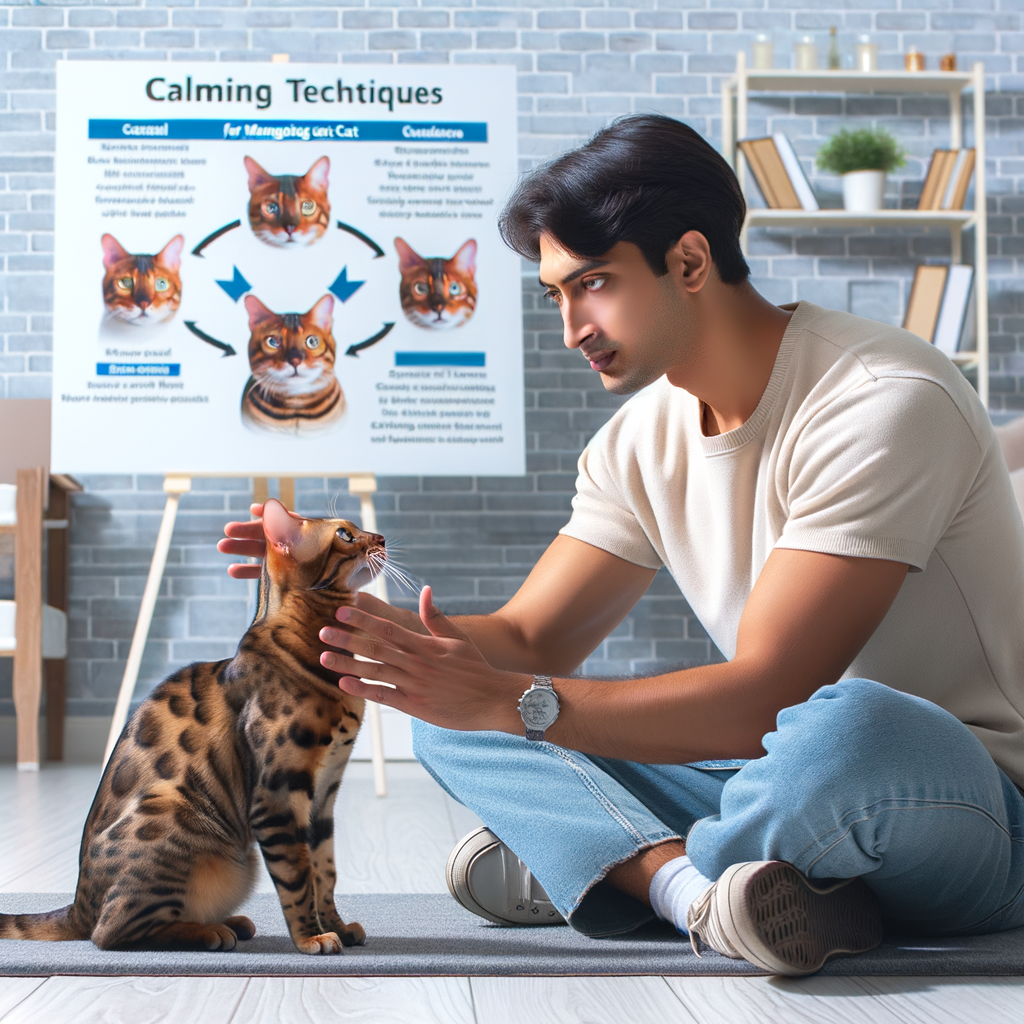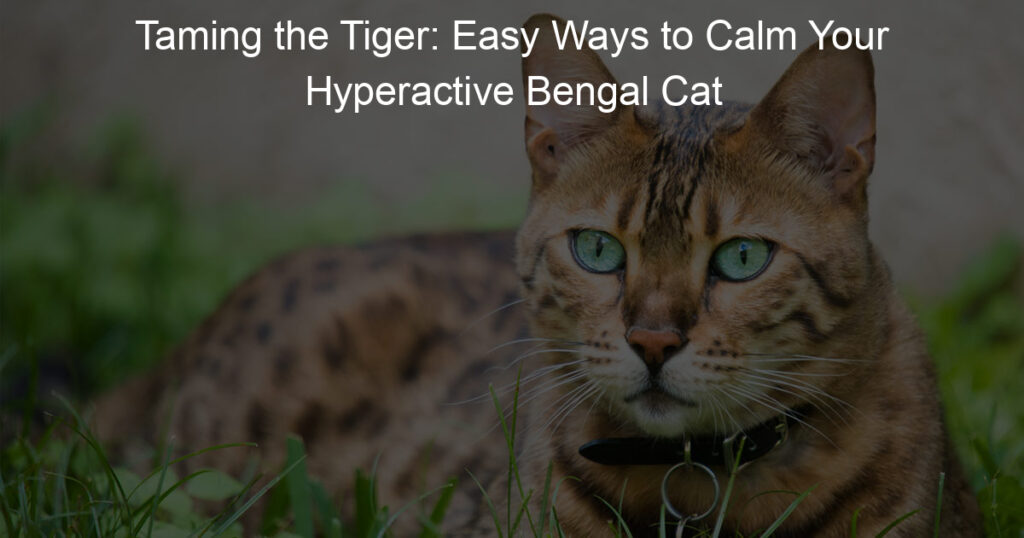
Introduction to Bengal Cat Behavior
Welcome to our comprehensive guide on Bengal cat behavior. In this section, we’ll delve into understanding the unique traits of these fascinating felines and debunk some common misconceptions about their hyperactivity. Let’s get started!
Bengal cats are known for their strikingly beautiful coats and playful, energetic personalities. But what sets them apart from other breeds? Here are some unique traits:
Intelligence: Bengals are highly intelligent and curious cats. They love to explore their surroundings and can often be found investigating every nook and cranny of their home.
Playfulness: Bengals are incredibly playful and need plenty of mental and physical stimulation. They enjoy interactive toys and games that challenge their minds.
Affectionate: Despite their wild appearance, Bengals are very affectionate and enjoy spending time with their human family members. They are known to form strong bonds with their owners.
Many people believe that Bengal cats are hyperactive and difficult to manage. However, this is a common misconception. While it’s true that Bengals are energetic and require plenty of playtime, they are not inherently hyperactive. Like any other breed, individual behavior can vary.
It’s important to remember that a Bengal’s energy levels can often be managed with regular exercise and mental stimulation. A bored Bengal cat may exhibit signs of hyperactivity simply because they are not getting enough stimulation. So, before labeling your Bengal as hyperactive, consider whether they are getting enough playtime and enrichment.
In the following sections, we’ll explore more about recognizing hyperactive behavior, its causes, and how to manage it effectively. Stay tuned!
Recognizing Hyperactive Bengal Cat Behavior
Understanding your Bengal cat’s behavior is crucial to ensuring their well-being. One of the behaviors that you might notice is hyperactivity. But how do you recognize it? Let’s delve into the signs of hyperactivity in Bengal cats and how it differs from normal cat behavior.
-
- Signs of Hyperactivity in Bengal Cats
Bengal cats are naturally active and playful. However, hyperactivity goes beyond the usual playful behavior. Here are some signs that your Bengal cat might be hyperactive:
-
-
- Excessive running or jumping around the house
- Constantly knocking things over
- Being awake and active for unusually long periods
- Aggressive or destructive behavior
- Excessive vocalization
-
If you notice these signs, it might indicate that your Bengal cat is hyperactive. Remember, every cat is unique, and what might seem like hyperactivity in one cat might be normal behavior in another. Always observe your cat’s behavior over a period of time before concluding.
-
- How Hyperactivity Differs from Normal Cat Behavior
It’s important to understand that hyperactivity is not the same as being active. Cats, especially Bengal cats, are naturally active creatures. They love to play, hunt, and explore. However, hyperactivity is different. It’s characterized by excessive and often destructive behavior that seems out of control.
For instance, a normal cat might play with a toy mouse, batting it around and chasing it. A hyperactive cat, on the other hand, might not only play with the toy mouse but also knock over furniture, scratch the carpet, and run around the house at top speed for hours on end.
Hyperactivity can also affect a cat’s sleep patterns. While it’s normal for cats to be awake and active during the night, a hyperactive cat might stay awake for unusually long periods, often seeming restless or agitated.
Understanding the difference between normal and hyperactive behavior can help you better care for your Bengal cat and ensure they’re happy and healthy.
Causes of Hyperactivity in Bengal Cats
Understanding the causes of hyperactivity in Bengal cats can help cat owners manage this behavior. There are two main factors that contribute to hyperactivity in Bengal cats: genetic factors and environmental factors.
-
- Genetic Factors Contributing to Bengal Cat Hyperactivity
Bengal cats are a breed known for their high energy levels. This trait is a part of their genetic makeup. Bengal cats are descendants of the wild Asian leopard cat, a species known for its agility and active nature. These traits have been passed down to Bengal cats, making them more active and energetic than many other cat breeds.
It’s important to note that not all Bengal cats will be hyperactive. Just like in humans, genetic traits can vary from one individual to another. Some Bengal cats may have a more laid-back personality, while others may be more active. However, if your Bengal cat is hyperactive, it’s likely that genetics play a role.
-
- Environmental Factors Influencing Bengal Cat Behavior
While genetics can play a role in a Bengal cat’s hyperactivity, environmental factors also have a significant impact. These factors can include the cat’s living conditions, diet, and level of stimulation.
Bengal cats are highly intelligent and need mental stimulation to keep them occupied. Without enough activities to engage their minds, they can become bored and may exhibit hyperactive behavior as a result. Similarly, a diet high in carbohydrates can lead to increased energy levels in cats, potentially contributing to hyperactivity.
Environmental stressors, such as changes in the household or a lack of routine, can also lead to hyperactive behavior in Bengal cats. Cats thrive on routine and can become anxious when their environment changes unexpectedly. This anxiety can manifest as hyperactivity.
In conclusion, both genetic and environmental factors can contribute to hyperactivity in Bengal cats. By understanding these factors, cat owners can take steps to manage their cat’s energy levels and provide a healthy, stimulating environment.
Calming Hyperactive Cats: General Techniques
Managing a hyperactive Bengal cat can be a challenge, but with the right techniques, it’s entirely possible. Here are some general strategies that can help calm your energetic feline and create a more peaceful home environment.
-
- Creating a Calm Environment
One of the most effective ways to calm a hyperactive cat is by creating a serene and peaceful environment. This can be achieved by minimizing loud noises and sudden movements, which can startle your cat and trigger hyperactivity. Soft, soothing music can also help to create a calm atmosphere. Additionally, providing a safe and comfortable space for your cat to retreat to when they feel overwhelmed can also contribute to a more relaxed demeanor.
-
- Using Interactive Toys to Manage Energy
Interactive toys are a fantastic way to help manage your Bengal cat’s energy levels. These toys can stimulate your cat’s hunting instincts, providing both mental and physical exercise. This can help to burn off excess energy and reduce hyperactive behavior. Examples of interactive toys include laser pointers, feather wands, and puzzle toys that dispense treats when solved.
-
- Establishing a Regular Feeding and Play Schedule
Establishing a regular feeding and play schedule can also help to calm a hyperactive cat. Consistency is key when it comes to managing your cat’s energy levels. Feeding your cat at the same times each day can help to regulate their energy levels, while scheduled playtimes can provide an outlet for pent-up energy. It’s also important to ensure that your cat is getting a balanced diet, as certain foods can contribute to hyperactivity.
Remember, every cat is unique and what works for one might not work for another. It’s important to be patient and try different techniques until you find what works best for your Bengal cat. With time and patience, you can help your hyperactive cat become a calm and content companion.
Bengal Cat Training Techniques
Training a Bengal cat can be a rewarding experience, especially when you use the right techniques. One of the most effective methods is positive reinforcement.
Positive Reinforcement
Positive reinforcement is a training method that rewards good behavior. This encourages the cat to repeat the behavior in the future. It’s a powerful tool for training Bengal cats, particularly in encouraging calm behavior.
-
- How to use treats to encourage calm behavior
Using treats as a form of positive reinforcement is a great way to encourage calm behavior in your Bengal cat. When your cat behaves calmly, immediately reward them with a small treat. This will help them associate calm behavior with positive outcomes. Remember, the key is consistency. Always reward good behavior immediately so your cat can make the connection.
-
- Training techniques for rewarding calm behavior
There are several techniques you can use to reward calm behavior in your Bengal cat. Along with treats, you can also use praise, petting, or playtime as rewards. For example, if your cat is calmly lying down, give them a gentle pet and verbal praise. This will reinforce the idea that calm behavior leads to positive attention.
Remember, patience is key when training your Bengal cat. It may take time for them to learn and understand what behavior is being rewarded. But with consistent positive reinforcement, your Bengal cat will soon learn to exhibit calm behavior more frequently.
Clicker Training
Clicker training is a fantastic technique that can help manage your Bengal cat’s hyperactivity. Let’s delve into the basics of this method and how it can be used effectively.
-
- Understanding the basics of clicker training
Clicker training is a type of positive reinforcement training. It involves using a small device that makes a distinct clicking sound. When your cat does something right, you click the device and reward them with a treat. This helps your cat associate the click sound with good behavior. Over time, your cat will start to understand that the clicking sound means they’ve done something good, and they’ll be more likely to repeat that behavior.
-
- How to use clicker training to manage hyperactivity
Hyperactive cats often have a lot of energy to burn. Clicker training can help channel that energy into positive behavior. Start by identifying the behaviors you want to encourage, such as sitting calmly or not jumping on furniture. When your cat exhibits these behaviors, click the device and give them a treat. Remember, patience is key. It may take some time for your cat to understand what the clicking sound means, but once they do, you’ll have a powerful tool to help manage their hyperactivity.
In conclusion, clicker training is a powerful tool that can help manage your Bengal cat’s hyperactivity. It’s all about patience, consistency, and positive reinforcement. So, why not give it a try? Your cat might just surprise you with their ability to learn and adapt.
Hyperactive Bengal Cat Solutions: Case Studies
Let’s delve into some real-life examples of how pet owners have successfully managed their hyperactive Bengal cats. These case studies will provide practical insights and proven strategies that you can apply with your own Bengal cat.
-
- Case study 1: Using environmental changes to calm a hyperactive Bengal cat
Meet Bella, a hyperactive Bengal cat who was causing her owner, Sarah, a lot of stress. Bella’s high energy levels were leading to destructive behavior around the house. Sarah decided to make some changes to Bella’s environment, and the results were impressive.
| Changes Made | Results |
|---|---|
| Introduced more toys and interactive play sessions | Bella’s destructive behavior reduced as she had a positive outlet for her energy |
| Created a quiet, safe space for Bella to retreat to | Bella started using this space when she felt overwhelmed, helping her calm down |
Sarah’s story shows that simple environmental changes can have a big impact on a Bengal cat’s behavior.
-
- Case study 2: Successful use of training techniques for a hyperactive Bengal cat
Next, we have Max, a Bengal cat who was always on the go. His owner, John, decided to try some training techniques to help manage Max’s hyperactivity. Here’s what he did and the results he achieved.
| Training Techniques Used | Results |
|---|---|
| Implemented a regular exercise routine | Max’s energy levels became more manageable and predictable |
| Used reward-based training to encourage calm behavior | Max started to understand and respond to commands, helping him calm down when needed |
John’s experience demonstrates that with patience and the right techniques, training can be an effective solution for managing a hyperactive Bengal cat.
These case studies highlight the importance of understanding your Bengal cat’s needs and behaviors. By making environmental changes or using training techniques, you can help manage your cat’s hyperactivity and improve their overall wellbeing.
Managing Bengal Cat Energy: Exercise and Play
One of the most effective ways to manage the high energy levels of Bengal cats is through regular exercise and play. Not only does this provide them with the physical stimulation they crave, but it also helps to keep them healthy and happy.
-
- Importance of regular exercise for Bengal cats
Regular exercise is crucial for Bengal cats. These cats are known for their high energy levels and athletic abilities. Without regular exercise, they can become restless and may even develop behavioral issues. Exercise helps to burn off their excess energy and keeps them physically fit. It also provides mental stimulation, which is just as important for their overall well-being.
-
- Best types of play for Bengal cats
Bengal cats enjoy a variety of play activities. They love to climb, so a cat tree or cat tower can provide hours of fun. Interactive toys that move or make noise can also keep them entertained. Games that mimic hunting, such as chasing a feather on a string or a laser pointer, can satisfy their natural instincts. Remember, the key is to keep the play sessions engaging and fun for your Bengal cat.
Here’s a simple table summarizing the importance of exercise and the best types of play for Bengal cats:
| Aspect | Details |
|---|---|
| Importance of Exercise | Helps burn off excess energy, keeps the cat physically fit, and provides mental stimulation. |
| Best Types of Play | Climbing on cat trees or towers, playing with interactive toys, and games that mimic hunting. |
In conclusion, managing the energy of a Bengal cat requires regular exercise and engaging play. By understanding their needs and providing appropriate activities, you can ensure your Bengal cat is happy, healthy, and well-behaved.
Dealing with Hyperactive Bengal Cats: Professional Help
While it’s perfectly normal for Bengal cats to have a high energy level, sometimes their hyperactivity can become a concern. It’s important to know when to seek professional help and what types of professionals can assist you in managing your Bengal cat’s behavior.
-
- When to seek professional help for your Bengal cat’s hyperactivity
If your Bengal cat’s hyperactivity is causing harm to itself, other pets, or people in your household, it might be time to seek professional help. Other signs that professional intervention may be necessary include:
-
-
- Your cat’s hyperactivity is not improving despite your best efforts at home.
- Your cat is showing signs of stress or anxiety, such as excessive grooming, loss of appetite, or changes in litter box habits.
- Your cat’s hyperactivity is interfering with its ability to rest or sleep.
- Types of professionals who can help with Bengal cat behavior management
-
There are several types of professionals who specialize in cat behavior and can help manage your Bengal cat’s hyperactivity:
-
- Veterinarians: They can rule out any medical conditions that might be causing your cat’s hyperactivity and can provide advice on behavior management strategies.
- Animal Behaviorists: These professionals have advanced training in animal behavior and can provide in-depth behavior assessments and personalized training plans.
- Professional Cat Trainers: They can provide hands-on training to help manage your cat’s behavior. They often use positive reinforcement techniques to encourage desired behaviors.
Remember, every Bengal cat is unique, and what works for one may not work for another. It’s important to be patient and persistent in your efforts to manage your cat’s hyperactivity. And don’t hesitate to seek professional help when needed. Your Bengal cat’s health and happiness are worth it!
Conclusion: Embracing Your Bengal Cat’s Energy
As we wrap up this comprehensive guide on Bengal cats and their energetic nature, it’s important to remember that every Bengal cat is unique. They are known for their high energy levels, but how they express this energy can vary greatly. Understanding and accepting your Bengal cat’s unique energy levels is the first step towards a harmonious relationship.
-
- Understanding and accepting your Bengal cat’s unique energy levels
Every Bengal cat is different. Some may be bouncing off the walls, while others may be more subdued. It’s crucial to understand this and not try to force your Bengal cat into a mold it doesn’t fit. Acceptance is key. Remember, their energy is part of what makes them special.
-
- How managing hyperactivity can improve your relationship with your Bengal cat
Managing your Bengal cat’s hyperactivity doesn’t mean suppressing it. Instead, it involves channeling it in a positive way. This could be through play, training, or other forms of exercise. By doing so, you can improve your relationship with your Bengal cat. They will see you as a source of fun and stimulation, rather than a threat or a bore.
Embracing your Bengal cat’s energy is not just about accepting their hyperactivity. It’s about understanding why they behave the way they do and finding ways to manage it. It’s about creating an environment where they can express their energy without causing disruption. And most importantly, it’s about enjoying the unique personality and quirks that make your Bengal cat who they are.
In conclusion, Bengal cats are a bundle of energy. They are lively, playful, and full of personality. While their energy levels can be challenging at times, with the right approach, you can turn this into a positive aspect of your relationship. So embrace your Bengal cat’s energy, and enjoy the vibrant, dynamic companion that they are.














